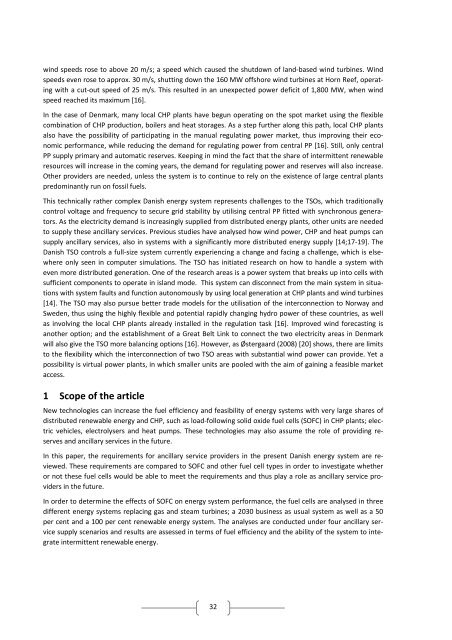Fuel cells and electrolysers in future energy systems - VBN
Fuel cells and electrolysers in future energy systems - VBN
Fuel cells and electrolysers in future energy systems - VBN
You also want an ePaper? Increase the reach of your titles
YUMPU automatically turns print PDFs into web optimized ePapers that Google loves.
w<strong>in</strong>d speeds rose to above 20 m/s; a speed which caused the shutdown of l<strong>and</strong>‐based w<strong>in</strong>d turb<strong>in</strong>es. W<strong>in</strong>d<br />
speeds even rose to approx. 30 m/s, shutt<strong>in</strong>g down the 160 MW offshore w<strong>in</strong>d turb<strong>in</strong>es at Horn Reef, operat‐<br />
<strong>in</strong>g with a cut‐out speed of 25 m/s. This resulted <strong>in</strong> an unexpected power deficit of 1,800 MW, when w<strong>in</strong>d<br />
speed reached its maximum [16].<br />
In the case of Denmark, many local CHP plants have begun operat<strong>in</strong>g on the spot market us<strong>in</strong>g the flexible<br />
comb<strong>in</strong>ation of CHP production, boilers <strong>and</strong> heat storages. As a step further along this path, local CHP plants<br />
also have the possibility of participat<strong>in</strong>g <strong>in</strong> the manual regulat<strong>in</strong>g power market, thus improv<strong>in</strong>g their eco‐<br />
nomic performance, while reduc<strong>in</strong>g the dem<strong>and</strong> for regulat<strong>in</strong>g power from central PP [16]. Still, only central<br />
PP supply primary <strong>and</strong> automatic reserves. Keep<strong>in</strong>g <strong>in</strong> m<strong>in</strong>d the fact that the share of <strong>in</strong>termittent renewable<br />
resources will <strong>in</strong>crease <strong>in</strong> the com<strong>in</strong>g years, the dem<strong>and</strong> for regulat<strong>in</strong>g power <strong>and</strong> reserves will also <strong>in</strong>crease.<br />
Other providers are needed, unless the system is to cont<strong>in</strong>ue to rely on the existence of large central plants<br />
predom<strong>in</strong>antly run on fossil fuels.<br />
This technically rather complex Danish <strong>energy</strong> system represents challenges to the TSOs, which traditionally<br />
control voltage <strong>and</strong> frequency to secure grid stability by utilis<strong>in</strong>g central PP fitted with synchronous genera‐<br />
tors. As the electricity dem<strong>and</strong> is <strong>in</strong>creas<strong>in</strong>gly supplied from distributed <strong>energy</strong> plants, other units are needed<br />
to supply these ancillary services. Previous studies have analysed how w<strong>in</strong>d power, CHP <strong>and</strong> heat pumps can<br />
supply ancillary services, also <strong>in</strong> <strong>systems</strong> with a significantly more distributed <strong>energy</strong> supply [14;17‐19]. The<br />
Danish TSO controls a full‐size system currently experienc<strong>in</strong>g a change <strong>and</strong> fac<strong>in</strong>g a challenge, which is else‐<br />
where only seen <strong>in</strong> computer simulations. The TSO has <strong>in</strong>itiated research on how to h<strong>and</strong>le a system with<br />
even more distributed generation. One of the research areas is a power system that breaks up <strong>in</strong>to <strong>cells</strong> with<br />
sufficient components to operate <strong>in</strong> isl<strong>and</strong> mode. This system can disconnect from the ma<strong>in</strong> system <strong>in</strong> situa‐<br />
tions with system faults <strong>and</strong> function autonomously by us<strong>in</strong>g local generation at CHP plants <strong>and</strong> w<strong>in</strong>d turb<strong>in</strong>es<br />
[14]. The TSO may also pursue better trade models for the utilisation of the <strong>in</strong>terconnection to Norway <strong>and</strong><br />
Sweden, thus us<strong>in</strong>g the highly flexible <strong>and</strong> potential rapidly chang<strong>in</strong>g hydro power of these countries, as well<br />
as <strong>in</strong>volv<strong>in</strong>g the local CHP plants already <strong>in</strong>stalled <strong>in</strong> the regulation task [16]. Improved w<strong>in</strong>d forecast<strong>in</strong>g is<br />
another option; <strong>and</strong> the establishment of a Great Belt L<strong>in</strong>k to connect the two electricity areas <strong>in</strong> Denmark<br />
will also give the TSO more balanc<strong>in</strong>g options [16]. However, as Østergaard (2008) [20] shows, there are limits<br />
to the flexibility which the <strong>in</strong>terconnection of two TSO areas with substantial w<strong>in</strong>d power can provide. Yet a<br />
possibility is virtual power plants, <strong>in</strong> which smaller units are pooled with the aim of ga<strong>in</strong><strong>in</strong>g a feasible market<br />
access.<br />
1 Scope of the article<br />
New technologies can <strong>in</strong>crease the fuel efficiency <strong>and</strong> feasibility of <strong>energy</strong> <strong>systems</strong> with very large shares of<br />
distributed renewable <strong>energy</strong> <strong>and</strong> CHP, such as load‐follow<strong>in</strong>g solid oxide fuel <strong>cells</strong> (SOFC) <strong>in</strong> CHP plants; elec‐<br />
tric vehicles, <strong>electrolysers</strong> <strong>and</strong> heat pumps. These technologies may also assume the role of provid<strong>in</strong>g re‐<br />
serves <strong>and</strong> ancillary services <strong>in</strong> the <strong>future</strong>.<br />
In this paper, the requirements for ancillary service providers <strong>in</strong> the present Danish <strong>energy</strong> system are re‐<br />
viewed. These requirements are compared to SOFC <strong>and</strong> other fuel cell types <strong>in</strong> order to <strong>in</strong>vestigate whether<br />
or not these fuel <strong>cells</strong> would be able to meet the requirements <strong>and</strong> thus play a role as ancillary service pro‐<br />
viders <strong>in</strong> the <strong>future</strong>.<br />
In order to determ<strong>in</strong>e the effects of SOFC on <strong>energy</strong> system performance, the fuel <strong>cells</strong> are analysed <strong>in</strong> three<br />
different <strong>energy</strong> <strong>systems</strong> replac<strong>in</strong>g gas <strong>and</strong> steam turb<strong>in</strong>es; a 2030 bus<strong>in</strong>ess as usual system as well as a 50<br />
per cent <strong>and</strong> a 100 per cent renewable <strong>energy</strong> system. The analyses are conducted under four ancillary ser‐<br />
vice supply scenarios <strong>and</strong> results are assessed <strong>in</strong> terms of fuel efficiency <strong>and</strong> the ability of the system to <strong>in</strong>te‐<br />
grate <strong>in</strong>termittent renewable <strong>energy</strong>.<br />
32

















